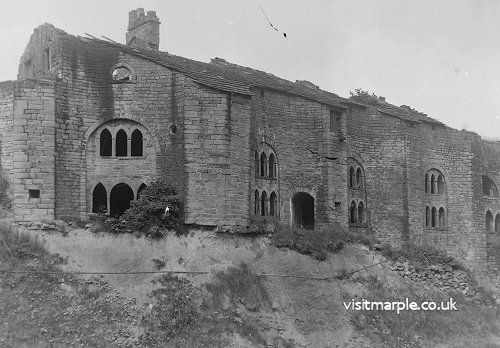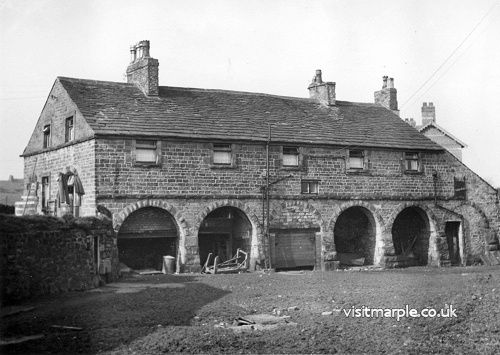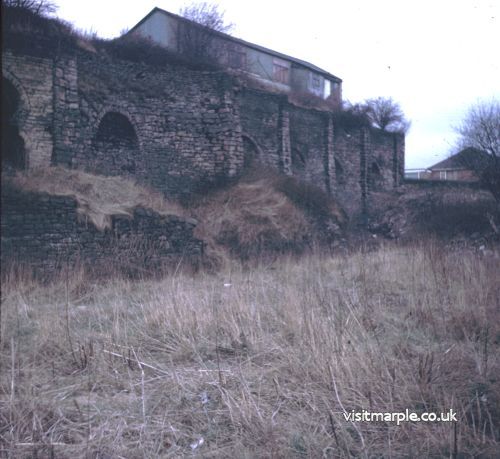 An image of the Lime Kilns from a glass negative,showing the scale of the working kilns.
An image of the Lime Kilns from a glass negative,showing the scale of the working kilns.
There are three main elements in the project for Revealing Oldknow’s Legacy - Marple Aqueduct, Mellor Mill and the Lime Kilns. The aqueduct is well-known and has just been repaired; excavations at Mellor Mill are well under way; but what about the Lime Kilns? Do they deserve more prominence and is anything happening to make them more accessible? Who better than the County Archaeologist for Greater Manchester, Norman Redhead.
He began by explaining just what a unique asset we had in the community. It was, and still is, one of the largest complexes in the country. It was notable for its gothic architecture, a statement of confidence and grandeur as it stared across the Goyt valley towards Mellor. And, uniquely, it incorporated housing in its design from the start.
 Lime loading shed where the carts loaded with burnt lime under cover.It was constructed over a period of five years from 1798 to 1803 in three separate phases and ancillary buildings followed. It was well thought out as from the start the raw materials of coal and limestone were brought by two canal arms within close proximity of the kilns to allow easy loading. The lime was unloaded from the base of the kilns, fifty feet below, and was taken away at that level. At first, whilst the locks were being built, there were private sidings leading into the main tramway going down to the lower canal level but, once the locks were complete, Oldknow had an arm of the canal excavated from Lock Twelve to the works. It was at this time that Posset Bridge got its name - Samuel Oldknow was so keen to be the first user of the new flight of locks that he encouraged the navvies excavating his private canal arm with a posset of ale. It was obviously an effective encouragement as his boat “Perseverance” was the first down the completed locks.
Lime loading shed where the carts loaded with burnt lime under cover.It was constructed over a period of five years from 1798 to 1803 in three separate phases and ancillary buildings followed. It was well thought out as from the start the raw materials of coal and limestone were brought by two canal arms within close proximity of the kilns to allow easy loading. The lime was unloaded from the base of the kilns, fifty feet below, and was taken away at that level. At first, whilst the locks were being built, there were private sidings leading into the main tramway going down to the lower canal level but, once the locks were complete, Oldknow had an arm of the canal excavated from Lock Twelve to the works. It was at this time that Posset Bridge got its name - Samuel Oldknow was so keen to be the first user of the new flight of locks that he encouraged the navvies excavating his private canal arm with a posset of ale. It was obviously an effective encouragement as his boat “Perseverance” was the first down the completed locks.
The kilns had a mixed commercial life. By 1802 they were producing 1200 tons per month and the lime was being shipped to the growing towns of Lancashire for building and for the new industries. About one third was used for agriculture to moderate the acidic soils and to make the earth more friable. By 1811 Oldknow leased the works as he developed other interests but he refused an offer of purchase by the Peak Forest Canal - he was only prepared to lease. After Samuel’s death ownership passed to the Arkwright family and they were managed by John Clayton &Co. who also ran Mellor Mill. Later in the century other operators took over and the works eventually closed in 1896.
Because of their national impo
Neil Mullineux, December 2015
Further reading:(Oldknow's Lime Kilns join England's top ten at risk heritage sites, Marple Lime Works, Mineral Mill & Brick Works on Peter Whitehead's excellent website)

